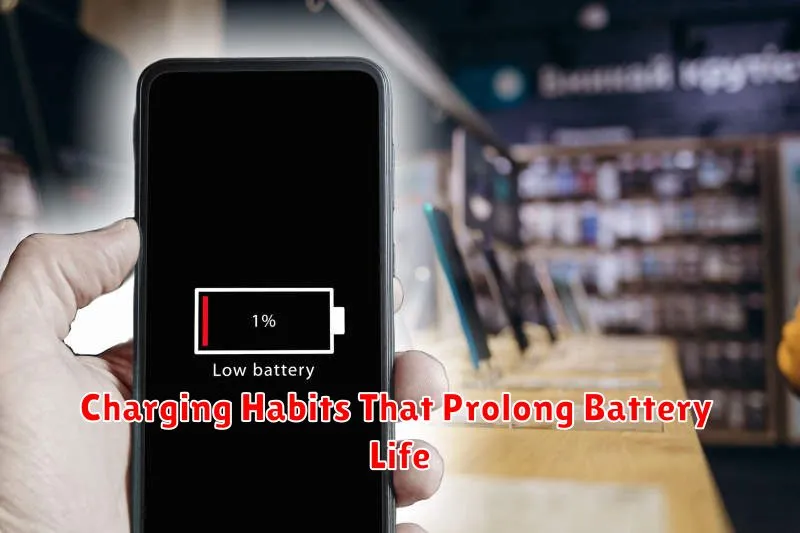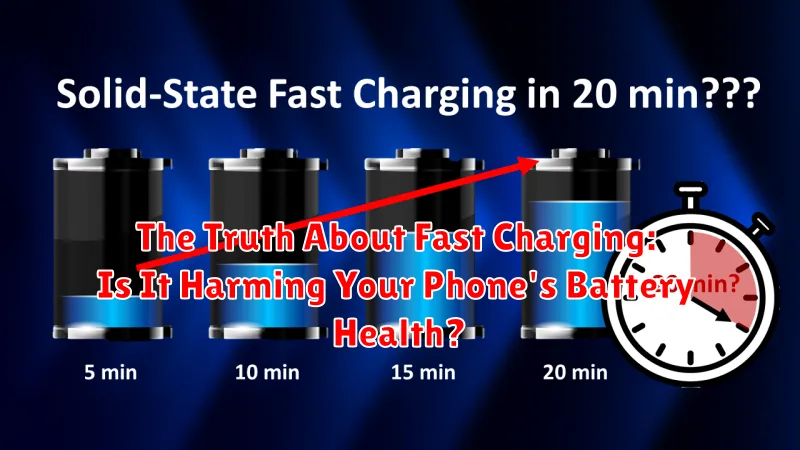In today’s fast-paced world, we demand instant gratification in every aspect of our lives, and our smartphones are no exception. Fast charging has become a ubiquitous feature, promising to replenish our dwindling battery life in record time. But amidst the convenience, a lingering question persists: is this rapid power delivery taking a toll on our phone’s battery health? This article delves into the truth about fast charging, exploring the underlying technology, its potential impact on battery longevity, and practical tips to mitigate any potential risks. We’ll examine whether the speed and convenience truly come at a cost, helping you understand how to best utilize fast charging while preserving your battery’s lifespan.
The allure of fast charging is undeniable – the ability to gain hours of usage from mere minutes of charging is undeniably attractive. However, concerns about battery degradation and potential long-term damage have led many to question the technology’s true impact. We will dissect the science behind fast charging, differentiating between various fast charging standards and their respective effects on battery health. By understanding the intricate relationship between charging speed, heat generation, and battery capacity, we aim to empower you to make informed decisions about how you charge your device and ultimately maximize its battery life.
How Fast Charging Works: Understanding the Technology
Fast charging technologies accelerate the charging process by manipulating the electrical current and voltage delivered to the phone’s battery. Standard charging typically uses a constant current approach. However, fast charging employs a more dynamic method.
Initially, fast charging delivers a higher current to a depleted battery. This takes advantage of the battery’s ability to accept a larger current when its charge is low. As the battery nears capacity, the charging circuitry intelligently reduces the current to prevent overheating and damage. Some fast charging technologies also manipulate voltage levels to optimize the charging process.
Different manufacturers implement fast charging differently, often utilizing proprietary technologies. These variations involve unique communication protocols between the charger and the device to negotiate optimal charging parameters. Understanding these underlying principles helps clarify how fast charging achieves significantly reduced charging times compared to standard charging methods.
The Potential Impact of Fast Charging on Battery Lifespan

While fast charging offers undeniable convenience, questions surrounding its long-term impact on battery health persist. The core concern lies in the potential for accelerated degradation compared to conventional charging methods.
Lithium-ion batteries, the standard in modern smartphones, have a limited number of charge cycles before their capacity starts to diminish. Fast charging, by its nature, stresses the battery more than standard charging. This increased stress can contribute to a slightly faster decline in the battery’s overall lifespan.
However, it’s important to understand the magnitude of this impact. Reputable manufacturers design their fast charging systems with safeguards to mitigate potential harm. The effect on lifespan is often minor, potentially shaving off a small percentage of the battery’s overall capacity over its lifespan, rather than causing drastic failure.
Furthermore, advancements in battery technology and fast-charging protocols continue to lessen this impact. Adaptive charging algorithms and optimized power delivery systems are becoming increasingly sophisticated, intelligently managing the charging process to minimize stress and prolong battery life.
Heat Generation and Battery Degradation
A key factor influencing battery degradation is heat. Fast charging, by its nature, generates more heat than standard charging. This elevated temperature accelerates the chemical reactions within the battery, which can contribute to a faster decline in its overall capacity over time.
Think of it like a chemical fire. A hotter fire burns faster and consumes fuel more quickly. Similarly, higher temperatures within a battery accelerate the chemical processes that provide power, leading to faster degradation.
While phone manufacturers implement various thermal management solutions to mitigate this, some heat generation is unavoidable. The extent of heat produced and its impact depends on factors like the specific fast charging technology used, the ambient temperature, and the battery’s age.
Optimizing Fast Charging for Battery Health
While fast charging offers undeniable convenience, adopting certain practices can help minimize any potential long-term impact on battery health. Avoid consistently charging to 100%. Keeping the battery charge level between 20% and 80% can significantly reduce stress on the battery.
Use the charger provided with your phone or a reputable third-party charger that’s compatible with your device’s fast charging technology. Generic or low-quality chargers may not regulate power delivery efficiently, potentially leading to overheating.
Avoid fast charging in extremely hot or cold environments. High temperatures, in particular, can exacerbate battery degradation. If your phone feels excessively warm while charging, disconnect it and allow it to cool down.
Consider turning off fast charging when it’s not needed. If you have ample time to charge, using standard charging speeds places less strain on the battery. Many phones allow you to toggle fast charging on or off in the settings.
Charging Habits That Prolong Battery Life

While fast charging offers convenience, adopting healthy charging habits can significantly extend your battery’s lifespan. Avoiding extreme battery levels is key. Don’t consistently let your battery drain to 0% or charge it to 100%.
Partial charging is preferable to full charges. Topping off your battery throughout the day, rather than waiting until it’s depleted, puts less stress on the battery. Aim to keep your charge level between 20% and 80% for optimal longevity.
Temperature also plays a crucial role. Avoid charging your phone in excessively hot or cold environments. Extreme temperatures can accelerate battery degradation. If your phone feels hot while charging, remove its case and discontinue charging until it cools down.
Finally, using the correct charger is important. While using a lower-power charger won’t necessarily harm your battery, it’s recommended to use the charger that came with your phone or a reputable alternative that’s compatible with your device’s specifications.
Myths and Misconceptions About Fast Charging
Several myths surround fast charging technology, often causing unnecessary concern about battery degradation. Let’s address some of these common misconceptions.
Myth 1: Fast charging will significantly damage your battery. While all charging generates some heat, modern smartphones incorporate sophisticated battery management systems and temperature regulation features to minimize any detrimental impact from faster charging speeds.
Myth 2: You should only use the charger that came with your phone. While using the manufacturer-provided charger is generally recommended, using a reputable third-party charger that adheres to industry standards is usually safe. The key is ensuring compatibility and certification.
Myth 3: Fast charging is always bad for your battery’s long-term health. The actual impact of fast charging is relatively minor compared to other factors like extreme temperatures and high discharge cycles. The convenience often outweighs the negligible long-term effects for most users.
Adaptive Charging and Battery Management Features
Modern smartphones incorporate sophisticated charging management systems to mitigate potential harm from fast charging. These systems work behind the scenes to optimize the charging process and protect the battery’s long-term health. Adaptive charging is a key feature that learns your charging habits and adjusts the charging speed accordingly. For example, it might fast charge your phone initially to get you to a usable percentage quickly and then slow down the charging rate as it approaches full capacity. This prevents overcharging and minimizes stress on the battery.
Other battery management features include temperature monitoring and voltage regulation. These systems constantly monitor the battery’s temperature and adjust the charging current to prevent overheating. They also ensure that the voltage supplied to the battery is within safe limits, further protecting it from damage. These features work together to maximize charging efficiency while minimizing the potential negative impacts of fast charging.
Choosing the Right Charger and Cable
Using the correct charger and cable is crucial for optimizing fast charging and preserving battery health. Always opt for chargers and cables that are certified by your phone’s manufacturer. These accessories are designed to deliver the appropriate voltage and amperage to your specific device.
Avoid using counterfeit or cheaply made chargers, as these can pose safety risks and may not adhere to proper charging standards. They could deliver inconsistent power, potentially harming your battery or even your phone.
The cable itself also plays a vital role. Ensure you’re using a cable that supports the fast charging protocol of your device. A damaged or low-quality cable can hinder charging speeds and even cause overheating.
Check your phone’s user manual or the manufacturer’s website to identify recommended chargers and cables. Investing in quality charging accessories is a small price to pay for protecting your phone’s battery and overall longevity.
Long-Term Battery Care Tips
Maintaining your phone’s battery health over time requires a proactive approach. While charging habits play a role, other factors significantly influence long-term battery performance.
Avoid extreme temperatures. Both excessive heat and extreme cold can stress the battery and diminish its capacity. Store your phone in a moderate temperature environment.
Manage app usage. Certain apps consume significant power even when running in the background. Regularly review your app usage and close power-hungry applications when not in use.
Update your software. Software updates often include optimizations for battery performance. Keeping your phone’s operating system and apps up-to-date is crucial for long-term battery health.
Reduce screen brightness. High screen brightness is a major power drain. Adjust your screen’s brightness to a comfortable level to conserve battery life. Enable adaptive brightness for automatic adjustments based on ambient lighting.

